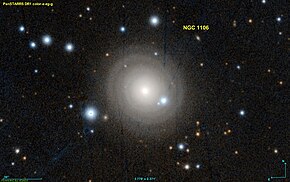| NGC 1106 | |
|---|---|
 | |
| Observation data ( J2000 epoch) | |
| Right ascension | 02h 50m 40.51s [1] |
| Declination | +41° 40′ 17.4″ [1] |
| Redshift | 0.014467 ± 0.000063 [1] |
| Heliocentric radial velocity | 4337 ± 19 km/s [1] |
| Distance | ~199 ± 14 · 106 Mly [1] (61.0 ± 4.3 Mpc) |
| Apparent magnitude (V) | 12.5 [1] |
| Apparent magnitude (B) | 13.5 [1] |
| Surface brightness | 12.7 mag/arcmin2 [1] |
| Characteristics | |
| Apparent size (V) | 1.30 x 1.0 arcmin [1] |
| Other designations | |
|
UGC 2322,
MCG 7-6-76,
ZWG 539.112, PGC 10792, IRAS 02474+4127 | |
NGC 1106 is a lenticular, non-barred spiral galaxy with considerable structure (type SA0^+), located in the Perseus constellation. [1] [2] It was first observed by astronomer John Herschel in 1828. [3]
In 2016, astronomers confirmed NGC 1106 contains a Compton-thick [4] active galactic nucleus, after extensive analysis of the galaxy's X-ray spectra. [5] Due to the AGN in its center, it's also classified as a type II Seyfert galaxy, meaning it has the characteristic bright core of a Seyfert galaxy, as well as appearing bright when viewed at infrared wavelengths.
A study released in 2022 detected active star formation in NGC 1106. [6] The research involved the use of far-ultraviolet and mid-infrared analysis, both techniques are extensively used as star formation rate tracers. [7]
Other Seyfert galaxies include:
- ^ a b c d e f g h i j "Revised NGC Data for NGC 1106". spider.seds.org. Retrieved 2023-12-02.
- ^ "NASA/IPAC Extragalactic Database's result for NGC 1106". ned.ipac.caltech.edu. Retrieved 2023-12-02.
- ^ "Dreyer". www.klima-luft.de. Retrieved 2023-12-02.
- ^ "Compton Thick AGN: The dark side of the X-ray background - A. Comastri". ned.ipac.caltech.edu. Retrieved 2023-12-03.
- ^ Tanimoto, Atsushi; Ueda, Yoshihiro; Kawamuro, Taiki; Ricci, Claudio (2016-06-01). "Suzaku follow-up of heavily obscured active galactic nuclei detected in Swift/BAT survey: NGC 1106, UGC 03752, and NGC 2788A". Publications of the Astronomical Society of Japan. 68: S26. arXiv: 1601.05056. Bibcode: 2016PASJ...68S..26T. doi: 10.1093/pasj/psw008. ISSN 0004-6264.
- ^ Kolokythas, Konstantinos; Vaddi, Sravani; O'Sullivan, Ewan; Loubser, Ilani; Babul, Arif; Raychaudhury, Somak; Lagos, Patricio; Jarrett, Thomas H. (2022-03-01). "The Complete Local-Volume Groups Sample - IV. Star formation and gas content in group-dominant galaxies". Monthly Notices of the Royal Astronomical Society. 510 (3): 4191–4207. arXiv: 2112.08498. Bibcode: 2022MNRAS.510.4191K. doi: 10.1093/mnras/stab3699. ISSN 0035-8711.
- ^ Brown, M. J. I.; Moustakas, J.; Jarrett, T. H.; Cluver, M. (2018). "The Ultraviolet–Infrared Color–Magnitude Relation of Star-forming Galaxies". Research Notes of the AAS. 2 (4): 217. arXiv: 1811.05638. Bibcode: 2018RNAAS...2..217B. doi: 10.3847/2515-5172/aaf21c. ISSN 2515-5172.
| NGC 1106 | |
|---|---|
 | |
| Observation data ( J2000 epoch) | |
| Right ascension | 02h 50m 40.51s [1] |
| Declination | +41° 40′ 17.4″ [1] |
| Redshift | 0.014467 ± 0.000063 [1] |
| Heliocentric radial velocity | 4337 ± 19 km/s [1] |
| Distance | ~199 ± 14 · 106 Mly [1] (61.0 ± 4.3 Mpc) |
| Apparent magnitude (V) | 12.5 [1] |
| Apparent magnitude (B) | 13.5 [1] |
| Surface brightness | 12.7 mag/arcmin2 [1] |
| Characteristics | |
| Apparent size (V) | 1.30 x 1.0 arcmin [1] |
| Other designations | |
|
UGC 2322,
MCG 7-6-76,
ZWG 539.112, PGC 10792, IRAS 02474+4127 | |
NGC 1106 is a lenticular, non-barred spiral galaxy with considerable structure (type SA0^+), located in the Perseus constellation. [1] [2] It was first observed by astronomer John Herschel in 1828. [3]
In 2016, astronomers confirmed NGC 1106 contains a Compton-thick [4] active galactic nucleus, after extensive analysis of the galaxy's X-ray spectra. [5] Due to the AGN in its center, it's also classified as a type II Seyfert galaxy, meaning it has the characteristic bright core of a Seyfert galaxy, as well as appearing bright when viewed at infrared wavelengths.
A study released in 2022 detected active star formation in NGC 1106. [6] The research involved the use of far-ultraviolet and mid-infrared analysis, both techniques are extensively used as star formation rate tracers. [7]
Other Seyfert galaxies include:
- ^ a b c d e f g h i j "Revised NGC Data for NGC 1106". spider.seds.org. Retrieved 2023-12-02.
- ^ "NASA/IPAC Extragalactic Database's result for NGC 1106". ned.ipac.caltech.edu. Retrieved 2023-12-02.
- ^ "Dreyer". www.klima-luft.de. Retrieved 2023-12-02.
- ^ "Compton Thick AGN: The dark side of the X-ray background - A. Comastri". ned.ipac.caltech.edu. Retrieved 2023-12-03.
- ^ Tanimoto, Atsushi; Ueda, Yoshihiro; Kawamuro, Taiki; Ricci, Claudio (2016-06-01). "Suzaku follow-up of heavily obscured active galactic nuclei detected in Swift/BAT survey: NGC 1106, UGC 03752, and NGC 2788A". Publications of the Astronomical Society of Japan. 68: S26. arXiv: 1601.05056. Bibcode: 2016PASJ...68S..26T. doi: 10.1093/pasj/psw008. ISSN 0004-6264.
- ^ Kolokythas, Konstantinos; Vaddi, Sravani; O'Sullivan, Ewan; Loubser, Ilani; Babul, Arif; Raychaudhury, Somak; Lagos, Patricio; Jarrett, Thomas H. (2022-03-01). "The Complete Local-Volume Groups Sample - IV. Star formation and gas content in group-dominant galaxies". Monthly Notices of the Royal Astronomical Society. 510 (3): 4191–4207. arXiv: 2112.08498. Bibcode: 2022MNRAS.510.4191K. doi: 10.1093/mnras/stab3699. ISSN 0035-8711.
- ^ Brown, M. J. I.; Moustakas, J.; Jarrett, T. H.; Cluver, M. (2018). "The Ultraviolet–Infrared Color–Magnitude Relation of Star-forming Galaxies". Research Notes of the AAS. 2 (4): 217. arXiv: 1811.05638. Bibcode: 2018RNAAS...2..217B. doi: 10.3847/2515-5172/aaf21c. ISSN 2515-5172.